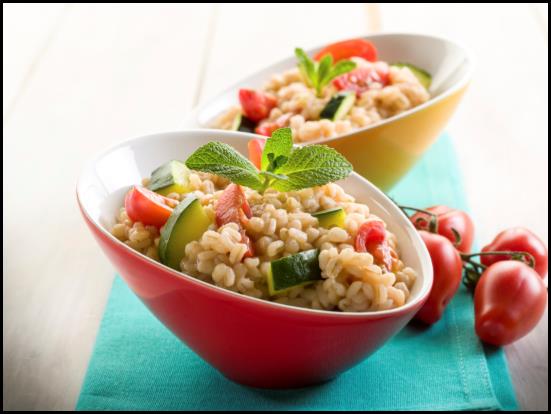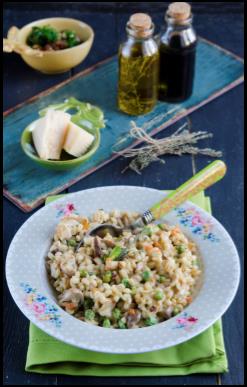| | Introduction | Barley an ancient grain | Recipe | Sources
.
Introduction

Barley is a nutritional powerhouse and the second largest cereal crop grown in Alberta. That said, less than one percent of barley is used as a food ingredient.
As cereal grains go, barley is a winner when it comes to good nutrition. This centuries-old grain is packed with fiber, contains important vitamins and minerals, is low in fat, and like all plant products, cholesterol-free.
Barley is a great source of dietary fiber and contains both soluble and insoluble fiber. Soluble fiber is effective in lowering blood cholesterol and can reduce the risk of heart disease.
Barley an Ancient Grain
Barley is the second largest cereal crop grown in Alberta. It is a multi-purpose crop grown for food, malting and general purposes (feed) across the Canadian Prairies. In 2014, there were an estimated 2.8 million acres harvested and an estimated production of over 4 million tonnes. Eighty per cent of barley goes to feed, nineteen per cent to malt and one per cent is used for human consumption.
The following table compares the annual consumption per person of barley compared to other various grains over a five year average.
Food Available in Canada kilograms/person/year)
| Food Available in Canada | 2010 | 2011 | 2012 | 2013 | 2014 |
| Wheat flour | 61.29 | 59.40 | 59.00 | 58.02 | 56.93 |
| Rye flour | 0.24 | 0.24 | 0.22 | 0.23 | 0.24 |
| Oatmeal and rolled oats | 0.99 | 1.25 | 1.71 | 1.64 | 0.54 |
| Pot and pearl barley | 0.08 | 0.46 | 0.36 | 0.38 | 0.36 |
Source: Statistics Canada Table 002-0011
|
One reason for the low consumption of barley could be product availability though most stores carry pot and pearl barley. Barley flour is available in some stores but it is not consistent. Community Natural Foods carries the widest selection of barley products but there are only four stores in Calgary. They carry pot barley, hulled barley, quick-cooking barley, barley flakes and barley flour. They also carry barley malt syrup, barley grass juice powder and barley flakes. Bulk Barn carries barley flour as well.
Barley contains important vitamins and minerals, is low in fat, and, cholesterol-free. It is also beneficial in slowing the absorption of sugar and potentially reducing the risk of developing Type 2 diabetes.
Here are some of the potential benefits of adding barley to your diet.
- Barley is naturally cholesterol-free and low in fat. (A 1/2-cup serving of cooked pearl barley, a typical grain serving, contains less than 1/2 gram of fat and only 100 calories.)
- Contains several vitamins and minerals including niacin, thiamine, selenium, iron, magnesium, zinc, phosphorus and copper.
- Contains antioxidants.
- Contains phytochemicals.
- Barley is an excellent choice when it comes to adding both soluble and insoluble fiber to the diet. Barley compares favourably to other grains in total dietary fiber content. For example, a 1/2-cup serving of cooked pearl barley contains 3 grams of total dietary fiber. In comparison, a 1/2-cup serving of cooked long-grain brown rice contains 1.75 grams dietary fiber. The same serving of cooked white medium-grain rice contains less than 1 gram of dietary fiber.
Barley is a whole grain, comes with a cholesterol lowering health claim, grown in North America and is non-GMO. When you look at consumers' health concerns, barley can address many of them.
Consumers are looking for ways to sustain their health as they age. They are reading labels more and wanting less sodium and sugar in their foods. There is also a trend towards buying local and non-GMO foods.
Barley addresses all of these concerns. Try a change of pace and use barley instead of potatoes, pasta or rice in your recipes.

Recipe
Try this recipe to get you started on the path to using barley more frequently.
Thai Barley Salad - Yields 4 to 6 servings
INGREDIENTS
For the salad:
1 cup barley, rinsed*
1 ½ cups water
1 ½ cups low-sodium vegetable broth
2 medium carrots, peeled and shredded
2 cups sliced cabbage (or coleslaw mix)
4 green onions, thinly sliced
½ cup frozen shelled edamame, thawed
½ cup unsalted peanuts
1 mango, diced
¼ cup cilantro, chopped
For the sauce:
¼ cup creamy peanut butter
¼ cup water
1 tablespoon honey
1 tablespoon soy sauce
1 tablespoon rice vinegar
1 teaspoon freshly grated ginger
INSTRUCTIONS
Add the barley, water and broth to a medium saucepan. Bring the mixture to a boil, give it a stir, cover, then reduce the heat to medium-low / low and let simmer for about 40 to 60 minutes*. It should be tender but a little bit chewy. Drain off any excess liquid if there is any and add to a large bowl. Let cool slightly, about 10 to 15 minutes.
Add in the carrots, cabbage, green onions, edamame, peanuts, mango and cilantro. Toss to combine.
In a small bowl, whisk together all the ingredients for the sauce until well combined and mostly smooth. Pour into the bowl with the barley and toss until combined. Season with salt and pepper to taste, if needed. Serve at room
temperature or chilled.
Source:
http://cookiemonstercooking.com/2014/05/26/thai-barley-salad/
Sources
Sarah Oliveira - Hulless Barley Potential Opportunities,
Alberta Agriculture and Forestry,
Economics and Competitiveness Division,
September 2015
|
|